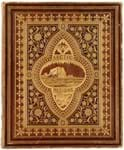Until the end of the 17th century truly portable mercury barometers were unknown. The instruments had to be carefully dismantled for transport, otherwise the mercury could escape from the glass bowl, rendering it unusable.
In 1695 Quare applied for a patent and was soon able to present his construction, which was favourably received by the members of the Royal Society. They praised the fact that it could be inverted without spilling the “quick silver”.
The central 2ft 11in (90cm) tall ivory column is supported by four folding metal feet, the silvered barometer scale at the top is engraved on one side in English and on the reverse in French.
Below it is a brass plate with the signature: Invented & Made / by Dan l Quare / London.
Portable barometers with either walnut or ivory shafts by Quare can be found in major museum collections around the world, from the V&A to the Metropolitan Museum of Art.
More than one example belongs to the Royal Collection, one of which is in the King’s Bedroom in Hampton Court Palace. Similar pieces have been known to bring well over €100,000, such as the version sold for a premium-inclusive £121,250 at Sotheby’s London in December 2012.
Dorotheum’s version, which came from a Belgian private collection, had much more modest expections of €30,000, partly due to its less than perfect condition but also presumably because, being made of ivory, its appeal made it a more problematic potential purchase for some. The auctioneers’ caution proved well founded: it ended up selling for €30,000 (£26,085).















